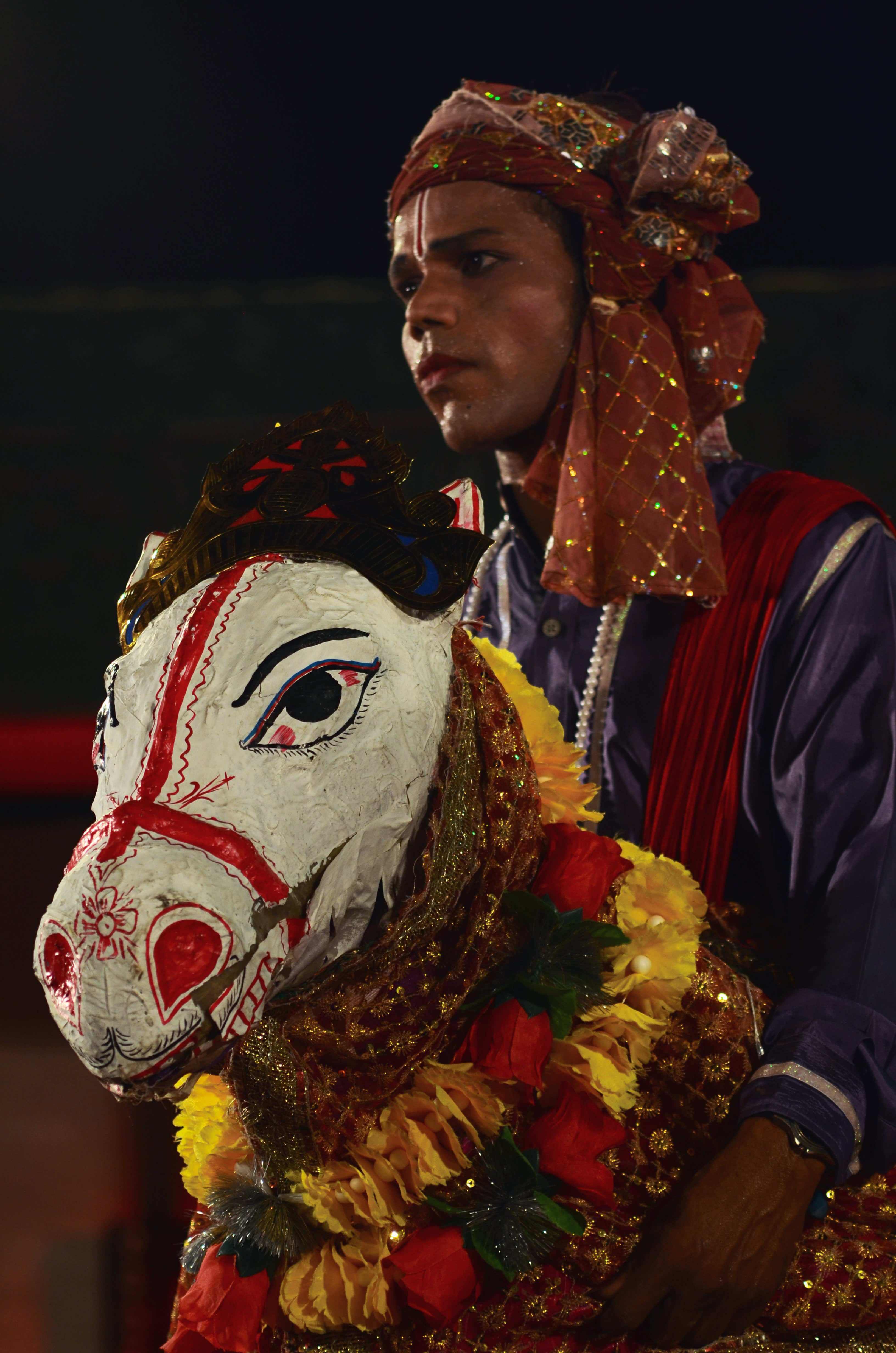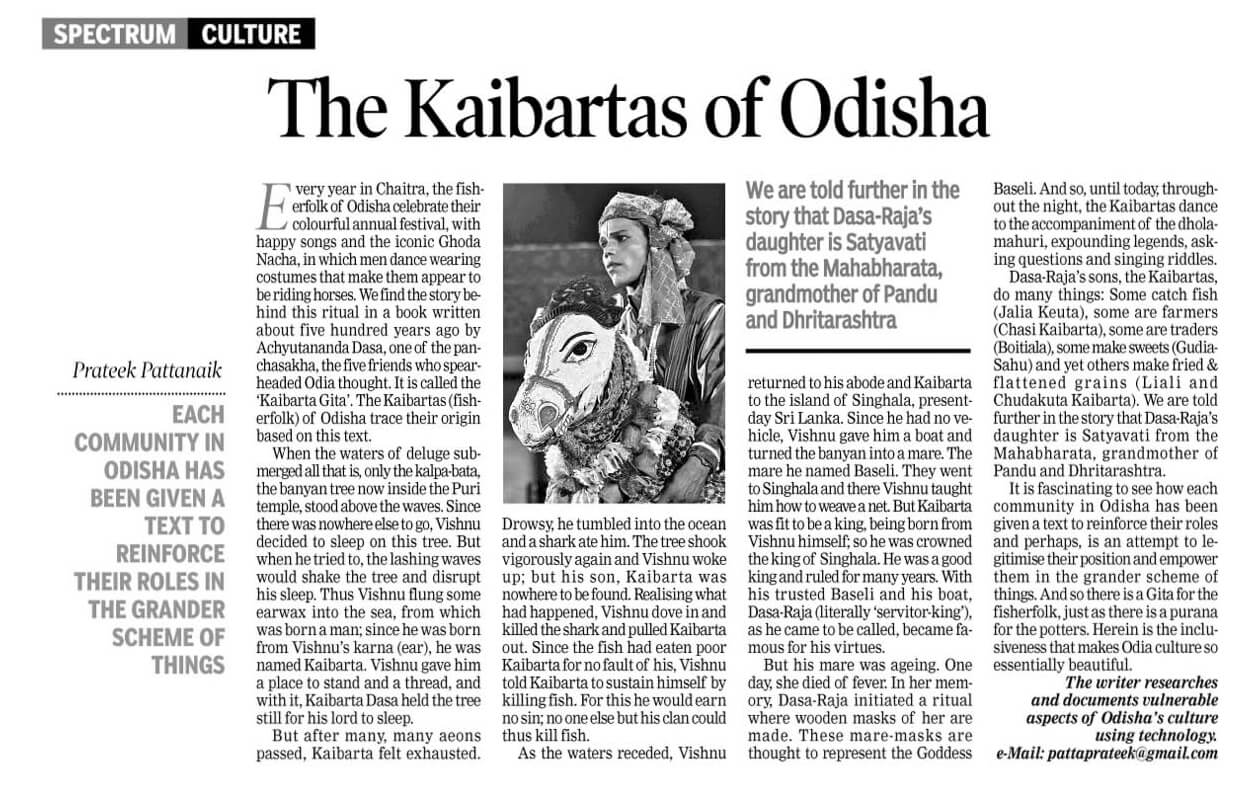Published on 23 Apr 2019 in OrissaPOST
Every year in the month of Chaitra, the fisherfolk of Odisha celebrate their colourful annual festival, with happy songs and the iconic Ghoda Nacha, in which men dance wearing costumes that make them appear to be riding horses. We find the story behind this ritual in a book written about five hundred years ago by Achyutananda Dasa, one of the panchasakha, the five friends who spearheaded Odia thought. It is called the ‘Kaibarta Gita’. The Kaibartas (fisherfolk) of Odisha trace their origin based on this text.

When the waters of deluge submerged all that is, only the kalpa-bata, the banyan tree now inside the Puri temple, stood above the waves. Since there was nowhere else to go, Vishnu decided to sleep on this tree. But when he tried to, the lashing waves would shake the tree and disrupt his sleep. Thus Vishnu flung some earwax into the sea, from which was born a man; since he was born from Vishnu’s karna (ear), he was named Kaibarta. Vishnu gave him a place to stand and a thread, and with it, Kaibarta Dasa held the tree still for his lord to sleep.
We are told further in the story that Dasa-Raja’s daughter is Satyavati from the Mahabharata, grandmother of Pandu and Dhritarashtra
But after many, many aeons passed, Kaibarta felt exhausted. Drowsy, he tumbled into the ocean and a shark ate him. The tree shook vigorously again and Vishnu woke up; but his son, Kaibarta was nowhere to be found. Realising what had happened, Vishnu dove in and killed the shark and pulled Kaibarta out. Since the fish had eaten poor Kaibarta for no fault of his, Vishnu told Kaibarta to sustain himself by killing fish. For this he would earn no sin; no one else but his clan could thus kill fish.
As the waters receded, Vishnu returned to his abode and Kaibarta to the island of Singhala, present-day Sri Lanka. Since he had no vehicle, Vishnu gave him a boat and turned the banyan into a mare. The mare he named Baseli. They went to Singhala and there Vishnu taught him how to weave a net. But Kaibarta was fit to be a king, being born from Vishnu himself; so he was crowned the king of Singhala. He was a good king and ruled for many years. With his trusted Baseli and his boat, Dāsa-Rājā (literally ‘servitor-king’), as he came to be called, became famous for his virtues.
But his mare was ageing. One day, she died of fever. In her memory, Dasa-Raja initiated a ritual where wooden masks of her are made. These mare-masks are thought to represent the Goddess Baseli. And so, until today, throughout the night, the Kaibartas dance to the accompaniment of the dhola-mahuri, expounding legends, asking questions and singing riddles.
Dasa-Raja’s sons, the Kaibartas, do many things: Some catch fish (Jalia Keuta), some are farmers (Chasi Kaibarta), some are traders (Boitiala), some make sweets (Gudia-Sahu) and yet others make fried & flattened grains (Liali and Chudakuta Kaibarta). We are told further in the story that Dasa-Raja’s daughter is Satyavati from the Mahabharata, grandmother of Pandu and Dhritarashtra.
It is fascinating to see how each community in Odisha has been given a text to reinforce their roles and perhaps, is an attempt to legitimise their position and empower them in the grander scheme of things. And so there is a Gita for the fisherfolk, just as there is a purana for the potters. Herein is the inclusiveness that makes Odia culture so essentially beautiful.
The writer researches and documents vulnerable aspects of Odisha’s culture using technology. e-Mail: pattaprateek@gmail.com

One reply on “The Kaibartas of Odisha”
Beautiful ! thank you for introducing me to my roots.